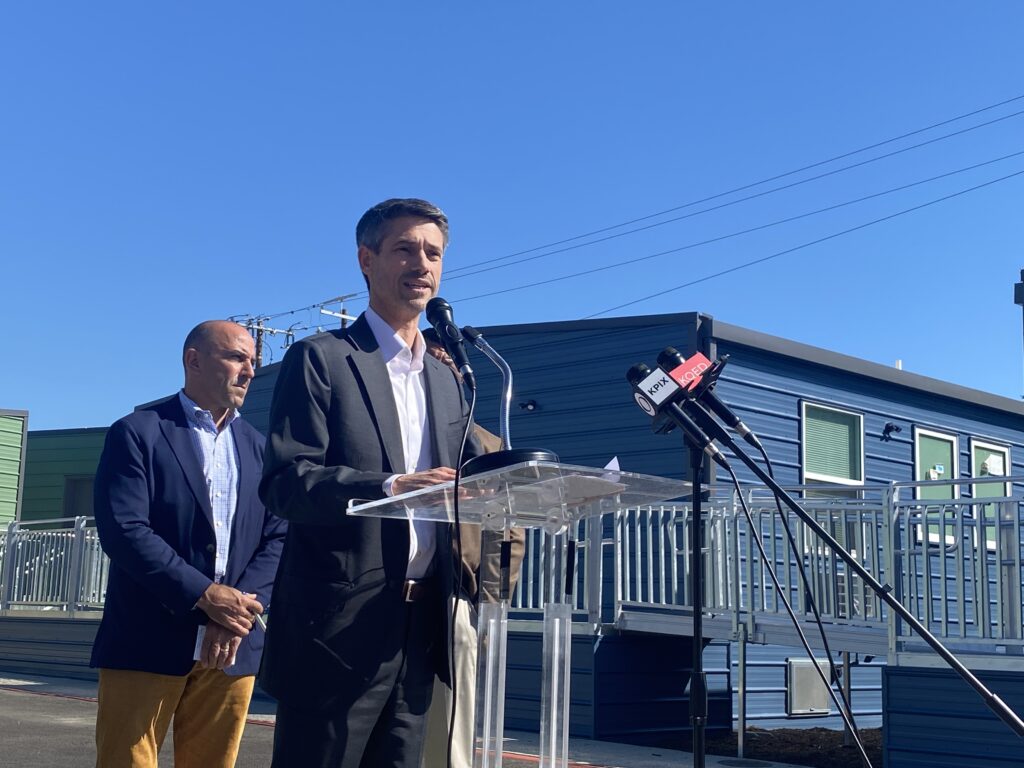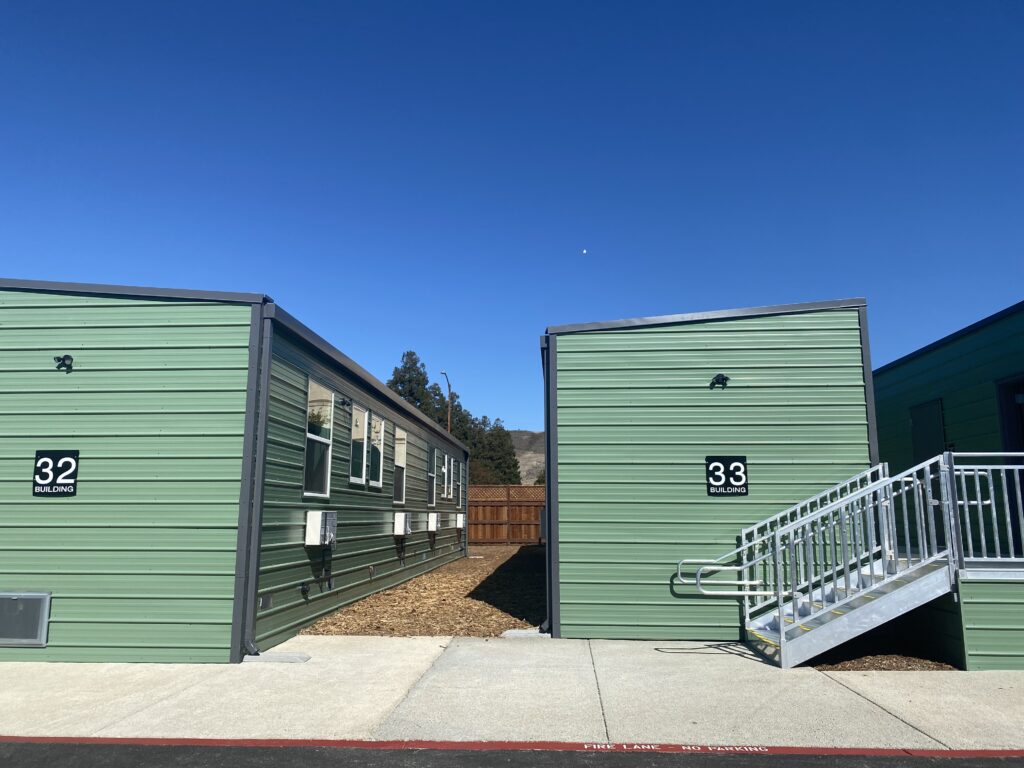One San Jose tiny home site has added more than 100 beds to house homeless residents, becoming the 10th temporary housing location to open or expand this year.
Rue Ferrari has become the city’s largest tiny home site, housing up to 266 formerly homeless individuals. The expansion has more than doubled its capacity, adding 108 tiny homes and 144 beds at 5898 Rue Ferrari. The rooms have private bathrooms, a central building for laundry and a shared kitchen. The complex features a security office, dog park, an outdoor picnic area, raised garden beds and additional storage units.
It cost more than $30 million to construct the additional homes and amenities, with $1 million in federal funding secured by Rep. Jimmy Panetta. The site will continue to be run by nonprofit HomeFirst, which provides case management. Rue Ferrari’s operating cost is expected to increase from $3.7 million to $5.4 million annually. Officials said they are on track to bring unsheltered homelessness down to 50% by the end of this year.
“We are making steady progress toward our goal of opening a thousand additional placements this year that are immediate, new alternatives to encampments,” Mayor Matt Mahan said at a Tuesday news conference. “I don’t think we’ve ever been over 50% sheltered.”
 San Jose Mayor Matt Mahan said the city is on track to reduce unsheltered homelessness to 50% by the end of the year. Photo by Joyce Chu.
San Jose Mayor Matt Mahan said the city is on track to reduce unsheltered homelessness to 50% by the end of the year. Photo by Joyce Chu.
Panetta said solving homelessness requires partnership in all levels of government.
“I’m ashamed to say that that type of leadership… isn’t coming these days from the White House,” he said at the news conference. “It is coming from the bottom up. It’s coming from leaders like Mayor Mahan who understand that they need to step up and do what he’s doing to solve these very, very difficult issues. I’m just proud that I can be a part of it. I’m proud that I made the federal government do its part.”
Rue Ferrari also received $16 million in Homeless, Housing, Assistance and Prevention (HHAP) funding from the state. Due to the budget deficit, the California Legislature did not include money for HHAP this fiscal year. This is the state’s main source of homelessness funding and is used toward prevention, rental assistance, temporary and permanent housing, outreach and shelter improvements.
“We’re living in a time when funding for homelessness solutions is unfortunately being cut at every level of government,” Mahan said. “Here in San Jose, we’re getting creative. We’ve just announced a new partnership with Santa Clara County to share costs and integrate our services and interim housing sites and strengthen that continuum from streets to stability onto permanent solutions.”
 The expanded Rue Ferrari tiny home community can house up to 266 formerly homeless individuals. Photo by Joyce Chu.
The expanded Rue Ferrari tiny home community can house up to 266 formerly homeless individuals. Photo by Joyce Chu.
In partnership with Santa Clara County, a team of workers from the county Valley Homeless Healthcare Program will visit San Jose shelters and provide mental health care services starting later this year. Mahan said this will help reduce the city’s costs around case management.
Even so, losing millions in HHAP funding will impact the city as it expands its temporary housing sites. Housing Director Erik Soliván previously said San Jose will lose about 550 beds if it doesn’t find other sources of funding. Because of the timing of when state dollars are distributed, the effect on the city won’t be felt until fiscal year 2026-27, with an expected loss of about $30 million.
Several sites have opened this year as the city looks to optimize operating costs amid cuts. This includes the Via del Oro and Branham Lane tiny home villages, Berryessa safe parking site, Taylor Street safe sleeping site and five motels — Alura Inn, Bristol Hotel, Motel 6, Fontaine Inn and Casa Linda Motel. The city covers meals, case management, security, building maintenance and more, which costs millions of dollars a year to operate.
The city has added 840 spaces this year, bringing the total number of spaces to 1,568. Two more tiny home sites at Cherry Avenue and VTA’s Cerone Yard are expected to open by the end of this year.
Mahan wants to achieve “functional zero” — when the number of people exiting homelessness is greater than the number of people becoming homeless — through short-term solutions such as tiny homes, safe parking and sleeping sites and shelters. In order to do so, it would cost roughly $234 million in annual operating costs to run the shelters at peak capacity, according to a housing department analysis. This ends up costing the city more in the long run than building permanent supportive housing.
Todd Langton, founder of Apage Silicon Valley, said Mahan is putting an over-emphasis on temporary housing.
“Is Mahan about optics, or is he about a permanent solution?” Langton told San José Spotlight. “Some of the people that we’ve helped get housed (in tiny homes) are back on the streets again because they were exited out. It’s not the solution. Hardly any (money is) going towards permanent (housing).” San Jose has 6,503 homeless residents, up 237 people from a 2023 point-in-time count. At the start of the year, about 60% were unsheltered, or 3,959 people.
San Jose has 6,503 homeless residents, up 237 people from a 2023 point-in-time count. At the start of the year, about 60% were unsheltered, or 3,959 people.
San Jose has significantly reduced the number of people living on the streets in the last few years. The homeless population peaked in 2022 at 6,650 people, when the city had the fourth highest homeless population per capita in the U.S. At that time, only 1,675 people were sheltered and nearly 5,000 were unsheltered.
Jorge, a resident of the original Rue Ferrari site who didn’t provide his last name, said he’s been able to grow and find safety after four years of living on the streets.
“I changed a lot. It has helped me so much,” he said at the news conference. “I’m really thankful for that… I was able to be one of the lucky ones, to able to get a bed here and to be safe.”
Contact Joyce Chu at [email protected] or @joyce_speaks on X.

